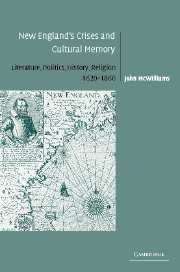Book contents
- Frontmatter
- Contents
- Acknowledgments
- Introduction: Crisis rhetoric: exclusion in New England history
- PART ONE PLANTATION AND SETTLEMENT
- PART TWO TIME OF TROUBLES
- Headnote
- 4 A cloud of blood: King Philip's War
- 5 The axe at the root of the tree: Scarlet Governors and Gray Champions
- 6 Race, war, and white magic: the neglected legacy of Salem
- PART THREE REVOLUTION
- Epilogue: “bodiless echoes”
- Notes
- Index
6 - Race, war, and white magic: the neglected legacy of Salem
Published online by Cambridge University Press: 22 September 2009
- Frontmatter
- Contents
- Acknowledgments
- Introduction: Crisis rhetoric: exclusion in New England history
- PART ONE PLANTATION AND SETTLEMENT
- PART TWO TIME OF TROUBLES
- Headnote
- 4 A cloud of blood: King Philip's War
- 5 The axe at the root of the tree: Scarlet Governors and Gray Champions
- 6 Race, war, and white magic: the neglected legacy of Salem
- PART THREE REVOLUTION
- Epilogue: “bodiless echoes”
- Notes
- Index
Summary
Since 1986 witchcraft (“Wicca”) has been a constitutionally protected religion; witch/wizard covens are maintained across the country, though they are, perhaps understandably, concentrated in Massachusetts. Nonetheless, the very mention of the seaboard city of “Salem,” for all except those who live there, has never shed its association with the infamous “Salem witch trials,” even though the trials arose in the neighboring inland community of Salem Village, now Danvers. Three centuries of notoriety have made the bibliography of the Salem witch trials (hearings, transcripts, polemics, history, historical fiction, drama, scholarship) so voluminous that no one can hope to master its entirety. My emphasis here is on exploring one long-neglected cause of the Salem trials, and studying selected renderings of it. During the sessions of the 1692 Special Court of Oyer and Terminer, confusions of racial color symbolism (red, black, and white) were expressed in the testimony of the afflicted who swore they had seen specters. Before, during, and after these testimonies, Essex County was sending its militia to fight Indians and Frenchmen who had been threatening and overrunning the county's northern borders since King Philip's War. The interconnections between these two developments demand our continuing attention if we are to understand not only the trials of 1692 but also the historiographical tradition that follows them.
It is particularly important that the racial and wartime dimensions of the Salem witch trials should have been so long obscured within the progressive New England historical tradition.
- Type
- Chapter
- Information
- New England's Crises and Cultural MemoryLiterature, Politics, History, Religion, 1620–1860, pp. 161 - 186Publisher: Cambridge University PressPrint publication year: 2004



